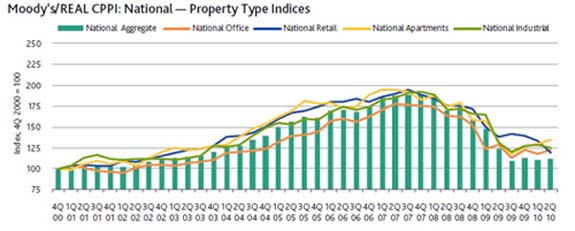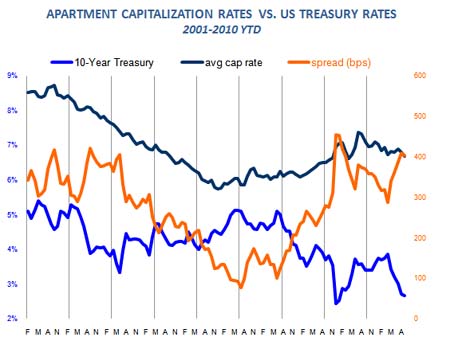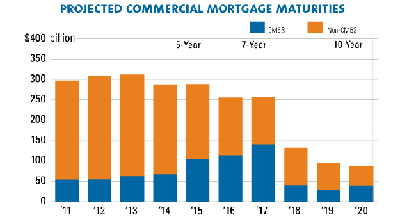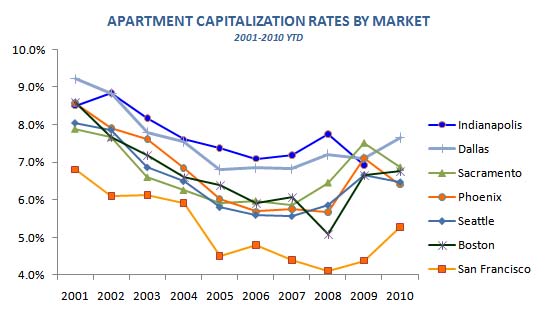In January, I was leading with my chin when I wrote Commercial Real Estate: $6.8 Trillion Reasons Why it Won’t Derail the Recovery. At the time, US GDP had just begun to turn around but job losses had yet to fully reverse, and based solely on the obvious strong demand for distressed assets of any kind, I argued that commercial real estate prices had hit bottom. As usual, the reader comments on that post turned out to be the most fun, informative part of the whole forward-leaning exercise (here is a direct link to the comment thread on that post).
Today, the Moody’s CPPI shows that a bottom is indeed forming. However, is there really any fundamental reason to believe that prices can recover strongly from here? If so, where is the economic growth that will cause that recovery to happen? And if there will be no growth or low growth, why pay for growth at all?

At this point, everybody knows that the regulators have given banks the green light to ignore their balance sheet problems, and while a rolling loan gathers conveniently gathers no loss, this practice has helped limit the supply of new product on the market. Combined with the historically wide Fed-engineered spreads between real estate yields and treasury rates, transaction volume and values have definitely been resuscitated, particularly for larger assets in primary markets:

However, this activity is not very broad-based. Real Capital Analytics reports that in July, 70% of all apartment sales occurred in primary markets. Through August, primary markets have captured 63% of all apartment investment dollars, well above the historical average of 53%.
But with weak fundamentals in every sector except apartments (REIS reports a .60% decline in nationwide vacancy rates during the third quarter, the sharpest quarterly drop since 2005), and with housing prices still soft, consumer spending still weak and job growth largely elusive, and with the deleveraging process in commercial real estate still far from over, how is a 5% capitalization rate anywhere, on any asset, ever going to be a profitable deal? And why would anyone pay for growth that now looks more and more illusory with each passing day?
Worse, if you’re like most people siting on a 5% cap rate in Chicago, Los Angeles, or Boston, you’re probably smearing lipstick on it with lower cost 5-7 year acquisition financing, perhaps with a 3 year IO term thrown in for good measure. Then you hold on and hope for 2006 to happen all over again, which is exactly what’s going to happen. Those 5-7 year loans will need to be refinanced just as $800 billion of 2005-2007 vintage commercial mortgages are maturing, including $350 million in poorly underwritten CMBS debt. Consequently, these borrowers face not only the prospect of lower growth, but also the possibility of a refinancing squeeze.

Furthermore, if interest rates increase as many expect, borrowers using 5 to 7-year loans today will find that refinancing rates are significantly higher in the future, even if credit availability improves. Higher interest rates and low growth will hinder these borrowers’ ability to successfully refinance, or if they choose to sell, to profitably exit their investments.
This concentration of investment in a limited number of markets has obviously created a mismatch between yields and risk. For example, apartment investors have also moved back into markets like Phoenix and Sacramento, where cap rates have trended sharply downward. Paradoxically however, every major job sector in Sacramento posted negative growth during the 8 months ended in August, yet capitalization rates decreased by 60 basis points over the same period. Sacramento’s economy is so weak that total non-farm employment has fallen to 839,400, a level not seen since the beginning of 2001. Full recovery will take years, not months.

So if low growth is the New Normal, where is the New Normal Old Hat? By definition, it is in the slow growth Midwest, where investors don’t pay for growth, even though it exists, and income is stable, predictable and quantifiable. More importantly, cap rate premiums of up to 250 basis points can be had over markets like Phoenix and Sacramento.
According to the Bureau of Labor Statistics, regional Midwestern hiring rates through June eclipsed hiring rates in every other region of the country, and states like Illinois, Pennsylvania and Minnesota were among the top 20 gainers in terms of jobs, with job increases of 1.2% or greater. In contrast, along with low cap rates, California commercial real estate investments also offer an economy that is continuing to struggle with a 12.4% unemployment rate, and a deeply indebted state government that can’t pass a budget.
Even more surprising is the rather boring (economically speaking, that is) slow growth state of Indiana, which boasts a budget that’s largely in the black, as well as the leading national private-sector job growth rate through June. For the twelve months ended in September, Indiana was 4th in the nation in private sector job growth, adding private sector jobs three and a half times faster than the nation as a whole, and Indiana unemployment claims have recently dropped to levels not seen since 2007.
Midwestern commercial real estate will never trade like an office building in San Francisco, and barriers to entry are certainly fewer, but the nearly 300 basis point yield spread between commercial real estate there and similar property in more popular “growth” markets no longer seems justifiable. I wouldn’t bet on cap rate compression in Cleveland anytime soon, but in a slow growth environment like the one we’re in, I certainly would not be falling all over myself for Sacramento and San Bernadino either.









 ShareThis
ShareThis




{ 1 trackback }
{ 0 comments… add one now }